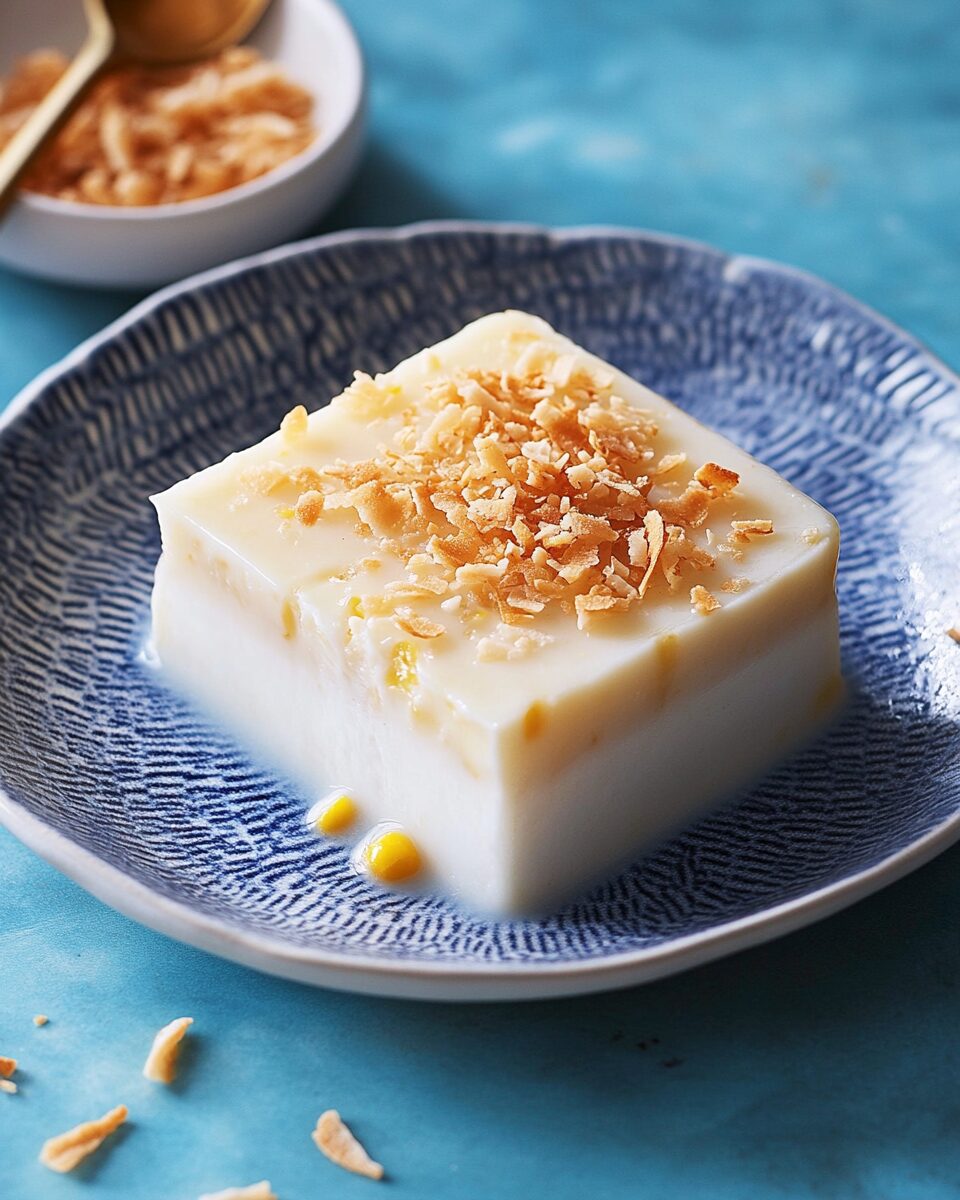A classic Filipino dessert, Maja Blanca is a smooth, creamy pudding made from coconut milk, corn, and cornstarch. Often served during holidays and celebrations, it’s easy to prepare and offers a delicious combination of sweetness and richness with a hint of corn flavor and a jelly-like texture.
FULL RECIPE:
Ingredients
- 4 cups coconut milk
- 1 can (14 oz) sweetened condensed milk
- 1 can (15 oz) whole kernel corn, drained
- 1/2 cup cornstarch
- 1/2 cup sugar
- 1/2 cup evaporated milk
- 1/4 cup grated cheese or toasted coconut flakes (optional topping)
Directions
- In a large pot over medium heat, combine coconut milk, sweetened condensed milk, evaporated milk, sugar, and corn. Stir until well combined.
- Bring the mixture to a gentle simmer, stirring occasionally.
- In a separate bowl, dissolve cornstarch in 1/2 cup water until smooth.
- Gradually pour the cornstarch slurry into the pot, stirring continuously to avoid lumps.
- Keep stirring over medium heat until the mixture thickens to a pudding consistency, about 10–15 minutes.
- Once thickened, pour the mixture into a lightly greased square or rectangular pan.
- Smooth the top and let it cool to room temperature. Then refrigerate for at least 2 hours to set.
- Once firm, slice into squares and top with grated cheese or toasted coconut flakes before serving.
Nutritional Information (Estimated per serving)
- Calories: 230
- Fat: 10g
- Saturated Fat: 8g
- Carbohydrates: 32g
- Sugar: 20g
- Fiber: 1g
- Protein: 3g
- Sodium: 60mg
Cultural Significance of Maja Blanca
Maja Blanca holds a special place in Filipino cuisine as a beloved dessert that is often prepared during holidays, fiestas, and family gatherings. Its origins trace back to the Spanish colonial period in the Philippines, where many local dishes were influenced by Spanish cuisine. The name “Maja Blanca” itself means “white delicacy” in Spanish, which reflects the dish’s pristine, creamy appearance. Over time, Filipinos adapted the dessert using native ingredients such as coconut milk and corn, which are abundant in the country. Today, Maja Blanca is not only a celebration staple but also a symbol of Filipino ingenuity in combining foreign techniques with local flavors.
Texture and Flavor Profile
One of the defining characteristics of Maja Blanca is its soft, jelly-like texture, which is achieved through the use of cornstarch as a thickening agent. This gives it a smooth and delicate consistency that sets it apart from other Filipino rice-based desserts like sapin-sapin or biko. The flavor is rich and creamy due to the generous use of coconut milk, which is naturally sweet and fragrant. Corn kernels add a slight crunch and subtle sweetness that contrast pleasantly with the silky pudding base. While the base recipe is mildly sweet, it is often balanced with a touch of salt or topped with grated cheese to add a savory dimension, making each bite more complex and enjoyable.
Variations Across Regions
Although the classic version of Maja Blanca uses coconut milk, cornstarch, and corn, many regions in the Philippines have developed their own versions of this dessert. Some include latik, which are coconut milk curds that have been fried until golden brown, used as a topping to add texture and flavor. Others may add a layer of sweetened purple yam (ube) or even include fruit preserves to give it a more festive look and taste. In urban areas, Maja Blanca is often modernized by adding toppings like caramel syrup, condensed milk drizzle, or even chocolate. These regional and personal variations reflect how Filipinos embrace creativity while preserving the heart of traditional recipes.
Occasions for Serving
Maja Blanca is a dessert deeply associated with celebration and togetherness. It is a popular choice during Christmas and New Year celebrations, as well as local town fiestas and family reunions. Its affordable ingredients and easy preparation make it accessible even to households on a tight budget. Because it is usually served cold, it provides a refreshing contrast to the array of savory dishes commonly served during Filipino gatherings. In recent years, it has also gained popularity in potlucks, school events, and catering services due to its simplicity, shelf-stability, and appeal to a wide range of palates.
Health Benefits and Considerations
While Maja Blanca is primarily a dessert, it does offer some nutritional value due to its coconut milk and corn content. Coconut milk contains healthy fats known as medium-chain triglycerides (MCTs), which may support metabolism and energy levels. Corn adds fiber and certain essential nutrients such as vitamin B and antioxidants. However, like most sweets, it is high in sugar and should be consumed in moderation, especially for individuals with dietary restrictions like diabetes. Alternative recipes have emerged for health-conscious individuals, using plant-based sweeteners, low-fat coconut milk, or even almond milk as a substitute, making it easier for more people to enjoy the dessert guilt-free.
Storage and Shelf Life
Maja Blanca is best stored in the refrigerator and can last for up to 3 to 5 days when kept in an airtight container. Its gelatinous texture remains stable under cold temperatures, although it is advisable to consume it within a few days to preserve its freshness and avoid microbial growth. Freezing is not typically recommended as it may alter the texture, causing the pudding to become watery upon thawing. When storing, toppings such as cheese or latik should ideally be added right before serving to maintain their taste and texture. Proper storage ensures that each serving retains the same delightful experience as the freshly made version.
Economic and Practical Appeal
One of the reasons why Maja Blanca remains a household favorite is its cost-effectiveness. The ingredients are readily available in most local markets and supermarkets and are relatively inexpensive. This makes it an ideal dessert option for large gatherings without the need for elaborate preparation or cooking equipment. It also requires minimal kitchen skills, allowing even beginner cooks to achieve impressive results. Moreover, it can be prepared in large batches, portioned easily, and even sold as a home business product. Many small-scale entrepreneurs in the Philippines have turned to selling Maja Blanca in plastic containers or trays, making it a source of livelihood as well as a cherished treat.
Popularity Beyond the Philippines
As Filipinos migrate around the world, they bring their culinary heritage with them. Maja Blanca has become a familiar presence in Filipino communities abroad, particularly in countries like the United States, Canada, Australia, and various parts of the Middle East. It is often featured in Filipino restaurants and bakeries catering to both fellow Filipinos and curious foreigners. The dessert’s unique yet comforting taste profile makes it appealing even to non-Filipinos, especially those who enjoy coconut-based desserts. It is commonly shared during cultural events, international food festivals, and potlucks, serving as a flavorful ambassador of Filipino culture.
Modern Twists and Experimentation
Today’s home cooks and chefs are constantly reinventing Maja Blanca to keep it exciting for new generations. Some experiment with color by adding natural food dyes like ube or pandan extract to create eye-catching layers. Others introduce flavors such as coffee, matcha, or mango to give it a unique twist. In upscale versions, toppings like roasted nuts, whipped cream, or even edible flowers are used for presentation. While the base remains rooted in tradition, these contemporary variations highlight the dessert’s versatility. Social media platforms have also played a role in spreading innovative Maja Blanca recipes, encouraging experimentation and preserving interest in this beloved delicacy.
Conclusion
Maja Blanca stands out as more than just a dessert. It is a testament to Filipino heritage, creativity, and resourcefulness. With its rich coconut flavor, gentle sweetness, and satisfying texture, it continues to captivate taste buds across generations and borders. Its adaptability in terms of flavor, presentation, and nutrition means that it can evolve while staying true to its roots. Whether enjoyed during a festive gathering or as a comforting homemade treat, Maja Blanca offers a taste of home, culture, and community. As global interest in Filipino cuisine grows, Maja Blanca remains a proud and delicious representation of what makes Filipino food so special.






